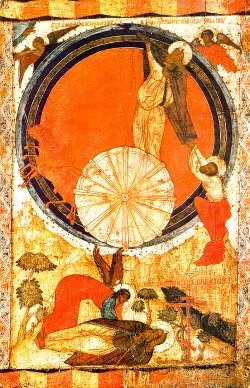
Northern School, 16th century.
The Tretiakov Gallery, Moscow, 99.5 x 64 cm.

The Fiery Ascension of Elijah the Prophet, painted in the sixteenth century, is classified as a work of the Northern school of icon painting. The Northern School can be described as a local, provincial, and archaizing school, which is often affected by folk art. The icon depicts several moments leading to the ascension of Elijah, but in comparison to similar icons from Novgorod, it gives a unique interpretation of the Biblical story. The painting's ornate border, vibrant colors, and carefully placed detail help to distinguish this icon from its counterparts. The story of Elijah is extremely important to the understanding and interpretation of the icon, as it is significant for both, Christianity and paganism. Beliefs associated with Elijah the prophet are among the clearest examples of the so-called double faith (dvoeverie). The saint became connected with Perun, the pagan god of thunder because of his own judgment by fire on Mount Carmel and, ultimately, because of his fiery ascension to heaven (Onasch, 379). Elijah's ascension in a chariot of fire gave him the title of protector from fire and thus turned him into one of the most popular saints. Elijah's importance to the inhabitants of Northern provinces rests on their belief that veneration should be given to the saints that could benefit the peasants in "their daily occupations...and preserve them from dangers" (Rice, 70). Thus, Elijah's famous fiery voyage became a popular topic of icons, particularly between the fourteenth and the sixteenth centuries. Elijah's Fiery Ascension is composed of three episodes: the prophet's fiery ascension, Elisha's attempt to hold his master up, and the angel's visit to Elijah. The most important episode is the prophet's ascension to heaven on a chariot pulled by three fiery horses. In this rendition, his chariot is not shown, only the fancy light-colored wheel substitutes for the commonly shown cart with spoke wheels. The bright red "fireball" is encircled by four blue, green, and brown bands. Desperately trying to save his master, the disciple, Elisha, is holding on to the coat of Elijah, while the prophet looks onward to the outstretched hand of Christ reaching for him out of heaven in the left upper corner. Two angels are hovering at each side of the fiery ball. They seem to escort Elijah to heaven; the one on the left announces the prophet's arrival, paving the way with music from a trumpet. In the bottom register, Elijah can be seen resting near a "juniper" bush while an angel urges him to eat, for he has a "...long way to go" (Onasch, 379). Scholars interpret this scene as an allusion to the Garden of Gethsemane. Near the head of the sleeping Elijah stands a red cross patterned with white dots. One of the most striking features of the Fiery Ascension are the bright and intense colors characteristic for Novgorod, Pskov, and Northern schools of icon painting. A few blue accents counter the impact of the red and yellow, balancing the composition and providing an element of interest that attracts the viewers' attention. The border of the icon, with its wonderful detail, reminds one of popular distaff designs. In addition to the more obvious characteristics of the icon, there are less apparent features that give the painting its vibrancy and grace. For instance, a standard feature of the Pskov school is the emphasis placed on emotions of the depicted characters, as well as their angularity and stockiness. In Elijah's Fiery Ascension, the faces of the characters play an important role in creating the emotional impact of the story; the face of the angel kneeling beside Elijah, the face of Elisha trying to pull him down to earth, the face of the prophet, and the faces of
the two angels above express strong emotions. It is worth noting that the figures do appear to be slightly more rounded and stockier than in the sixteenth-century
Muscovite works, noted for the elongation of figures. Finally, the details and the clear composition add to the unique quality of the work. The detail is not only seen in the border, but also in the trees, mountains, inscriptions, and carefully
ornamented clothing. All these elements make this rendition of Elijah's story one of the most unique Russian icons. Other icons devoted to the subject provide a wonderful comparison and prove the originality and uniqueness of this portrayal of Elijah. The similarities that most icons share are the basic compositional elements: the prophet in his fiery chariot, the fireball, Elisha trying to hold on to the prophet's cloak, angels, the river Jordan, the hand of God in heaven, and the sleeping Elijah attended by the angel. All the paintings place significant emphasis and devote most of the space to the large red fireball surrounding the chariot; however, the fireball is different in each icon -- sometimes it is shaped as a raindrop, sometimes as an oval. The color of the fireball may change: on a Novgorodian 16th-century icon it is a yellowish gold ball surrounded by a ring of red (see the picture on the right). In most icons, at least two angels are shown hovering around the outer perimeter of the fireball. The trumpeting angel is a detail that does not appear often in other icons. In addition, all of the icons show Elijah's disciple grasping to hold on to him and bring him back to earth. Smaller details differentiating the icons are the number of horses in the chariot, the chariot's shape, the cross near the body of Elijah, the vessels with food brought by an angel, and the trees and mountains. [F.S.]
[Sources: Onasch, Rice, Lazarev].
